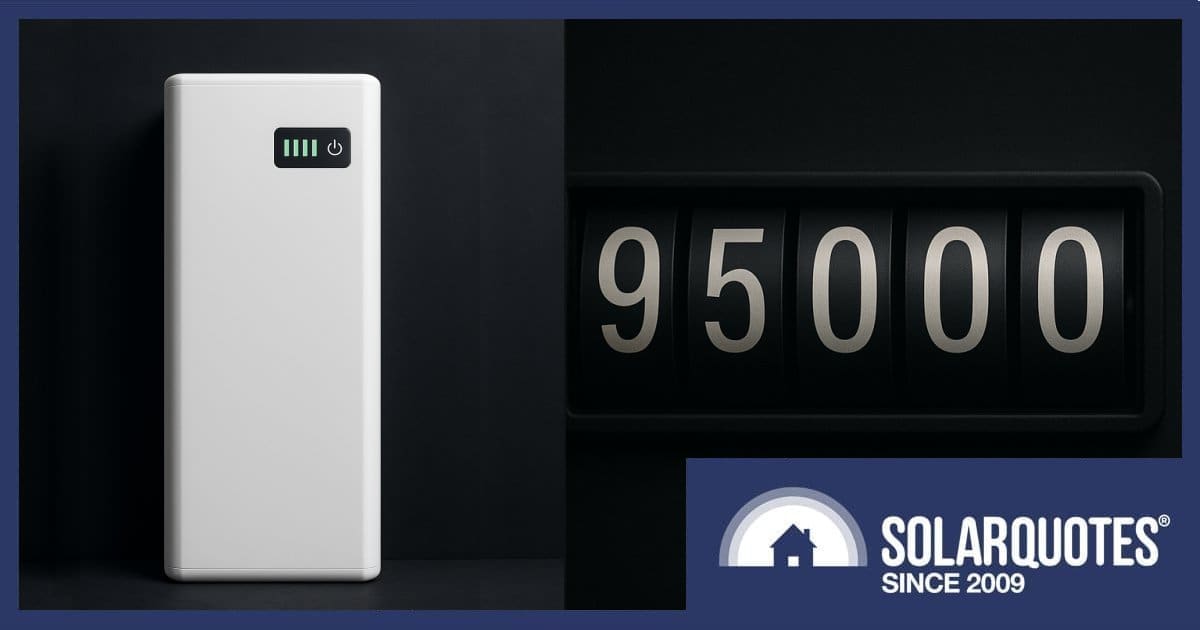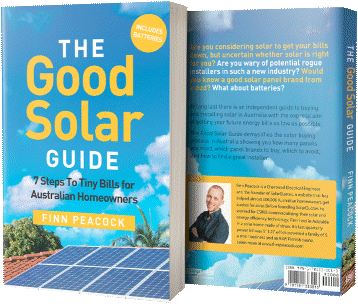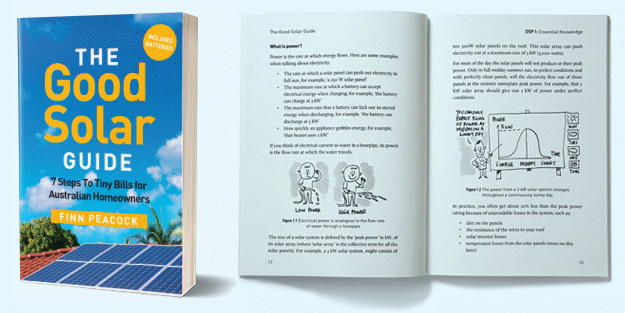
Federal Minister for Climate Change and Energy Chris Bowen provided an update yesterday on solar battery uptake numbers under the Albanese Government’s Cheaper Home Batteries (CHB) program.
How Many Home Batteries Have Been Installed Under CHB?
Minister Bowen said 95,000 batteries representing close to two gigawatt-hours of storage capacity have been installed in three and half months under the CHB initiative, which suggests an average capacity of 21 kWh1.
While the program formally launched on July 1 this year, some batteries had been installed but not commissioned for a couple of months prior to that date for eligibility reasons, and those that have since would be included in the total.
“We’ve seen the greatest uptake in outer suburban and regional areas, particularly in Queensland and South Australia,” the Minister said in his address to the AFR Climate and Energy Summit in Sydney yesterday.
Bowen pointed out that home battery uptake benefits all Australians — not only those who’ve installed a residential storage system. Storing surplus solar energy generated during the day assists in:
- Putting downward pressure on evening peak electricity prices through reduced mains grid demand.
- Reducing network infrastructure costs.
- Increasing utilisation of networks.
- Flattening the load profile over an average day, lowering hedging costs for electricity retailers.
- Mitigating the risk of costly interventions by the Australian Energy Market Operator (AEMO) to manage minimum operational demand risks in the middle of the day.
How Much Is The Battery Rebate In 2025, And In 2026?
Like the hugely popular national solar panel rebate, the CHB also operates under Australia’s Small-scale Renewable Energy Scheme (SRES); reducing each year on January 1 at this point for batteries.
The battery rebate (actually an up-front discount) is based on Small-scale Technology Certificates (STCs), which have a market value — generally around $36 each after admin fees and charges. An eligible battery receives around $338 rebate per kilowatt-hour of useable capacity in 2025, working out to be approximately a 30% discount on the upfront cost of installing. Systems installed from January 1, 2026 will receive around $302 discount per useable kilowatt-hour after admin fees.
So, (for example):
- An eligible 10 kWh battery installed in 2025 = 93 STCs = ~$3,350 discount
- An eligible 10 kWh battery installed in 2026 = 84 STCs = ~$3,020 discount
Households interested in taking advantage of the incentive might be hard-pressed to have a battery installed this year unless it has already been arranged, as many installers are flat out. But a rushed purchase decision can sometimes be the wrong one and the situation provides an opportunity to take a deep breath and research home batteries thoroughly before buying, ready for installation (hopefully) early next year.
Read further information on solar and battery rebates in 2026 here, and a full explainer of the Cheaper Home Batteries program here.
Electricity Reforms In The Pipeline
In other comments relating to home electrification and residential electricity prices, Minister Bowen said the Government has “plenty of work underway” for its National Consumer Energy Resources Roadmap, part of the Government’s broader reform process.
Concerning potential reforms to the Default Market Offer (DMO), consultation has been completed and he will be announcing next steps in the weeks ahead.
The DMO is meant to act as a safety net for customers who don’t choose a market electricity plan (which are usually cheaper). While a minority of Australian households are on such plans, the DMO sets the scene for market offer pricing. When DMO plan pricing goes up, others are likely to as well. The Department of Climate Change, Energy, the Environment and Water (DCCEW) is aiming to “strike a fair balance” between protecting customers and keeping incentives for electricity retailers to compete through the reforms.
Tackling Renewable Target Naysayers
The Albanese Government is shooting for 82% of Australia’s electricity to be generated from renewable energy sources by 2030.
Highlighting the success of the solar battery program was just one of the Minister’s many talking points in his speech. He said the Federal government, “most states”2, businesses and households are “getting on with the job” with the shift to renewables and electrification.
Some say the target can’t be reached.
“It can. It’s not inevitable, it’s not easy. In fact it’s a stretch, as it was intended to be,” said Bowen. “But those who sit around in 2025 and say ‘it’s all too hard and we should give up’ are, with respect, just plain wrong.”
The Minister’s address to AFR Climate and Energy Summit can be viewed in full here.
Footnotes
- Up until July, the average nominal capacity of fully-commissioned home batteries was around 11 – 12 kWh. In July, that jumped to 18.2 kWh, and appears to have continued increasing based on Bowen’s numbers. ↩
- Likely a swipe at Queensland, which is now potentially locked into expensive, filthy coal-fired power generation for decades to come after the Crisafulli Government’s Queensland Energy Roadmap was recently released; making the national target more challenging to achieve. ↩

 RSS - Posts
RSS - Posts



Yes this has been a runaway success
Surely someone is doing some modelling to show how evening demand is dropping in the system!
This is just begging for some flashy graphics!
Saul Griffiths advised them to do this at the start of their first term. it would have transformed the politics of renewables much earlier, taking the cheap point-scoring out of wind and solar farms. Go households first is necessary pubic policy strategy, let them see the benefits early rather than in the distance on some national roadmap.
The Albanese government began with the mistaken (and advised) view of simply replacing the old centralised generation and transmission model with new renewable generating sources and more transmission. They’re discovering now that the sweet spot is households.
Huge delays in obtaining certain well-known batteries.
Is this due to unequal distribution of supply (eg Vic/NSW vs Qld) or delays on import or delays in manufacturing?
Unable to ascertain the main reason, but suspect all three apply.
I wish to know the reasons too …. We signed up for a battery installation early this month (in Canberra). Received notification that our January 2026 installation date has been put back to mid-2026(!!) due to a supply issue with the battery. Deeply disappointed but glad one of the options we were given was a fixed price guarantee if we decided to wait.
Once you get up into bigger battery sizes – and a good part of why they are being chosen – the discount is closer to 50% than 30%. Especially with modular ones like Sig. The wiring, inverter, gateway, etc, aren’t subsidised, just kWh of storage. So, once all that gubbins is in, the more kWh you add, the better the % rate on your discount.
Problem is many households don’t need much above 10kWh so the larger sizes, while cheaper per kWh, are pointless expenditure. And the small ones are so expensive that the cost can’t justify their purchase.
Obviously some households either have different maths i.e. lower FiTs, higher charge per kWh and\or higher overnight use, or don’t care about the cost, they just want a battery system for reasons.
My Powerwall 2 will pay for itself well within its warranty period. It’s also given us a continuous power supply with more and more frequent disruptions to grid supply, with weather events. The microgrid capacity batteries give you is one of their best features, I think. I also use it to access and store very cheap grid power in winter.
Unless you join Amber VPP
[2] all the more reason for a new (resurrected) great big fat carbon tax.
Hi Ian,
Despite his short tenure, the astutely self described suppository of all knowledge is one of Australia’s most consequential Prime Ministers… for all the wrong reasons. The damage he’s done is incalculable.
Given the cost of living crisis, any new tax needs to be carefully thought about. Is it applied to imports i.e. a tariff, or a ‘sales tax’?
Should it be applied to essential products disfavoured by the current government e.g. fuel, by distance travelled e.g. European imports v New Zealand imports?
Or should it be applied on the basis of some form of carbon emission level e.g. CCP China (34.0% of global total) or Singapore (roughly 370x the average global CO2 emissions per km^2) versus South Africa or Vietnam (1% of global total, same as Australia) or Brazil (like Australia, roughly a quarter of the average global CO2 emissions per km^2)?
To say a fat tax is needed is easy, especially if you’re not in the firing line, but who will be hit, and what? Me, I’m favouring a fat tax on CCP products, but I suspect many here will oppose that and want it on other targets, possibly even essentials I favour, making it less a tax and more a sin tax power trip, possibly making life prohibitive!
. What cost of living crisis? (Or when wasn’t there one?)
. It should be a tax on ancient carbon pulled out of the ground from anywhere in the world.
. The tax could only apply in Australia. Our government can only tax our own production, imports, and exports.
. Comparing Australia’s emissions to any other country’s emissions should be normalised to emissions per head of population.
Wouldn’t it be wonderful to live to 300 years and be able to offer reasons why nothing was done. I don’t think our descendants would be impressed.
There is a (Peter Singer) thought experiment called the drowning child. What would you do? What would your peers think?https://en.wikipedia.org/wiki/Famine,_Affluence,_and_Morality
The Albanese cost of living crisis. And no, life was mostly fine pre-COVID, especially during the Howard years.
So basically you want a sin tax. We’re already diverging radically in views – Australia selling coal is a positive IMHO.
And again I disagree. The planet doesn’t care about the number of people on it, what matters is emissions per area. Perhaps emissions per capacity of area, but that’s far more complex.
Sure immortality, or long life, is interesting in theory, but would it be in practice? Would you want to be born in the 1600s then get to see WW1, WW2, and the spread of Communism? Nothing done about not a problem is fine, but future issues …
Singer? Haven’t heard that highly controversial name in a while! You ignore instincts v reason. You also assume a child’s life has value. You assume capacity, responsibility, and the view of ‘peers’ matters. Rationally, many arguments against intervention can be raised. Singer simply assumes “muddy clothes don’t matter”.
Hi John,
I have to pull you up there.
John Howard did incalculable damage.
Handed a floated dollar & reformed economy ready to fire, he then sold productive assets for one time sugar hits to the budget.
Took *temporary* income from the mining investment boom & structurally damaged the budget with *permanent* tax cuts.
Sold ⅔ of our gold at historic low prices.
Spent 10x R&D money on “clean coal” than he did renewables.
Signed gas contracts out to 2035 at 1998 prices with ZERO indexation or links to world pricing.
The Japanese onsell that LNG for profit, we know where the boats go.
So right now, that money could be in a sovereign wealth fund like Norway has.
Or the gas could be providing us cheaper electricity.
Howard & Costello were imbeciles.
Now we need some incentives for v2g their batteries are even bigger !!
VPP uptake: where are the numbers?
I keep hearing about Virtual Power Plants as the holy grail—spreading the load, supporting the grid, lowering prices, empowering communities. But where’s the data? Uptake figures seem conspicuously absent. Is it really only 4% participation?
If so… well, that didn’t work, did it.
We were sold a vision of decentralised energy resilience. Instead, it’s looking more like a brochure than a breakthrough.
Of course it worked. It was never about VPP’s, it was about reducing power bills and the load on the network during peak hours which it has done massively.
95,000 happy households.
190,000 happy voters.
190,000 voters who will now see clearly the benefit of renewables.
Word of mouth will mean many more households will take advantage of this excellent policy.
We had our first blackout since our SoFar battery was added to our system a few nights back and the backup switched in so fast that the lights did not even blink. But the TV went off as the power circuit it is on is not auto backed up so we knew something was wrong, then noticed the neighbourhood had gone dark.
Our place was the only shining light in the street for about two hours.
Great feeling isn’t it!
Yes it is Andrew but also a little weird having much of your house just keep working while all those around you have shut down.
We get quite a few blackouts every year here in regional Queensland so home batteries which offer instant blackout protection are a real plus.
The federal government has certainly done the right thing with the subsidy.
It’s more than a WIN-WIN the gold standard for something that’s a no brainer.
It’s a win for the home owner, it’s a win for the grid and it’s a big win for the minister and a gov that can truly govern with vision.
I’m not going to gush about Labor, but this policy is one of the bright spots and is indeed a no brainer for anyone who intends to stay under their own roof for five or more years.
Story this week about homes with solar commanding a premium at time of sale so maybe a no brainer for anyone with their own roof.
I think solar makes sense for rentals too but I was one of those *good* Landb*stards.
I have a battery and used the rebate. It’s been great personally. Haven’t used the grid in two months (24kwh of storage) until this week when it’s been unusually wet and cloudy in ADL.
The issue i see coming is when I inevitably have to use the grid because of a lack of sun to charge the battery, what will the price be to buy from the grid? The fixed costs for the non renewable power generation we can’t do without in winter, or for the one cloudy week we just had in ADL in spring will not go away. They will just be spread amongst the fewer kwh the retailers have to sell over the year.
Hopefully, just like this week, de wind she will be blowin’ and energy will be cheap.
Lots of peaking plant we have now survives on 2% utilisation.
I was surprised how well my setup went this week. 14kWh down to 80% yesterday am.
I recently added 6kWh and feel comfortable I will get through next winter with very little imports.
Hence the exorbitant daily connection fees We are getting stuck with
Exactly. I can see a world coming soon where we are 95% self reliant but pay 200% more per kwh we consume for the grid because of the fixed costs to produce energy on demand….which renewables are not.
Again I have a battery and love it…but only because the government made it financially sensible and the economics of renewables mean first in cash out for a few years before everyone suffers.
“what will the price be to buy from the grid?”
How long is a piece if string?
If you are going to ask “what will the price be to buy from the grid?” you need to qualify the question by indicating your location.
Whilst I am waiting for the BESS that I want, to become available (if it becomes available), with a new inverter that is of sufficient capacity (up until 205-06-30, we were limited to 5kW inverter capacity, on the SWIS grid, which is difficult for a whole of household protected circuit) , and, with a faster switchover time to backup power, the existing system is configured to draw from the grid between 1200 and 1500, to fully charge the BESS, at the lowest available rate (using time of use pricing) at 8 cents per kWh on the SWIS grid in WA.
So, you need to qualify your question, by indicating your location, and, then, doing some research, and, finding what pricing plans are available for your location.
Simple.
Nice to see some numbers for the Federal Battery Rebate.
Good luck trying to get something out of the WA Government.
There are supposedly 100,000 WA Battery Rebates available but the Minister cannot put up a number.
There are supposedly 20,000 households who will benefit from the $10,000 interest free loan but again, no numbers.
I suspect because it was a shambles for the first 3 months, pensioners being declined. Disabled, self funded retiress being declined and installers not being paid.
As it is a complusory VPP, surely there must be some idea of uptake and impact??
Would love to see the figures also!! WA AKA Wait Awhile state
Do you really expect that the Crook government will be open and accountable and honest about this, providing truthful information, like they were with the respective election scam?
Just remember peoples, what ever the government gives to you from one hand they are taking more from somewhere – and so we will be paying more somewhere and somehow and we may not like it because it will be way more than the rebate you people are talking about 😵💫😵💫😵💫😵💫
Oh well that’s told us.
Don’t take advantage of any ‘subsidies’ people coz someone has to pay
Now do diesel rebates negative gearing capital gains tax discounts and Super advantages.